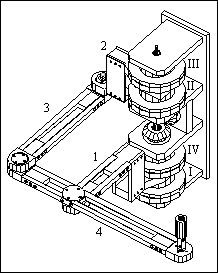
The goal of this research is to create a haptic, or touch, interface with another, presumably more complicated device, using only passive actuators. Some examples of haptic interfaces are force-feedback telerobotics, and virtual reality simulators which allow the user to "feel" the objects that they are sensing with their eyes. So what, you say? Devices to do those tasks already exist. These devices however probably use active actuators which are capable of increasing the energy of the system that they are controlling. This is great for the person designing the control algorithm because you have a lot of options and can modify the dynamics of the device considerably. Classical control methods can also be applied to the system fairly easily. There can be some drawbacks to having active actuators on such a device. One drawback is that in order to provide hard contraints the motors, or other powered actuator, must be able to generate very high forces or torques. If for some reason somthing goes wrong, there is the possiblity for the user to be injured. There may also be problems with stability using a controlled active device when encountering a constraint.
When one looks at what the goal of the device is, one can see that in may cases, these haptic interfaces only need to resist the user's motion. If this is the case, then a purely dissapative controller could be used. A passive controller fits in this category very nicely. That is the reason for this research. We're looking at using a purely passive device for the control of a haptic interface.
There are currently two approaches that I know of being taken to achieve a passive haptic interface. Our approach, which is to use varying degrees of energy dissapation to control tip trajectory and interface force, and the approach used at Northwestern, by Colgate and Peshkin, which uses a continuously variable transmission and no energy dissapation. As I see it, there are advantages and disadvantages to both approaches.
To find out more about our approach, you can download some papers if you wish.